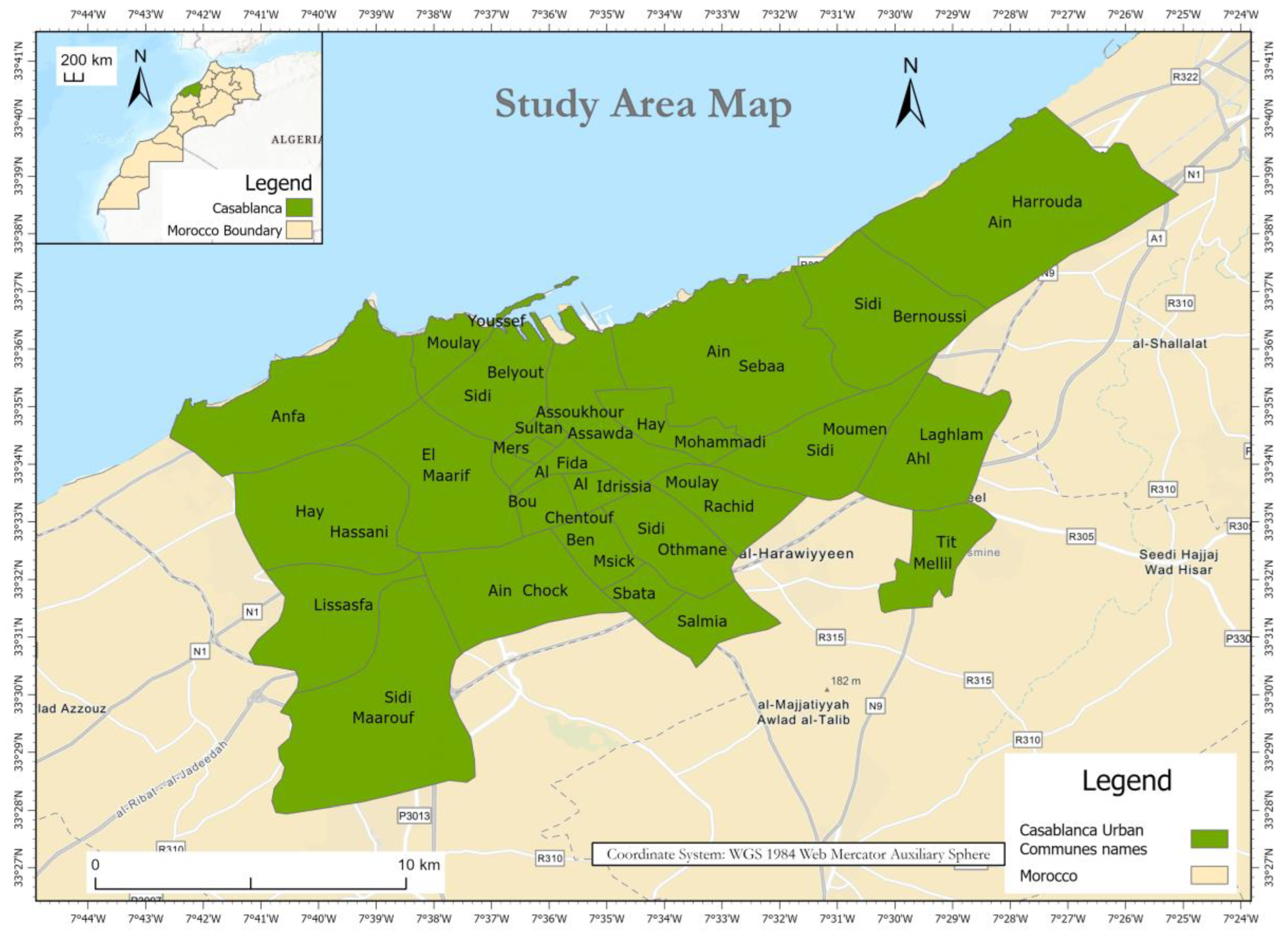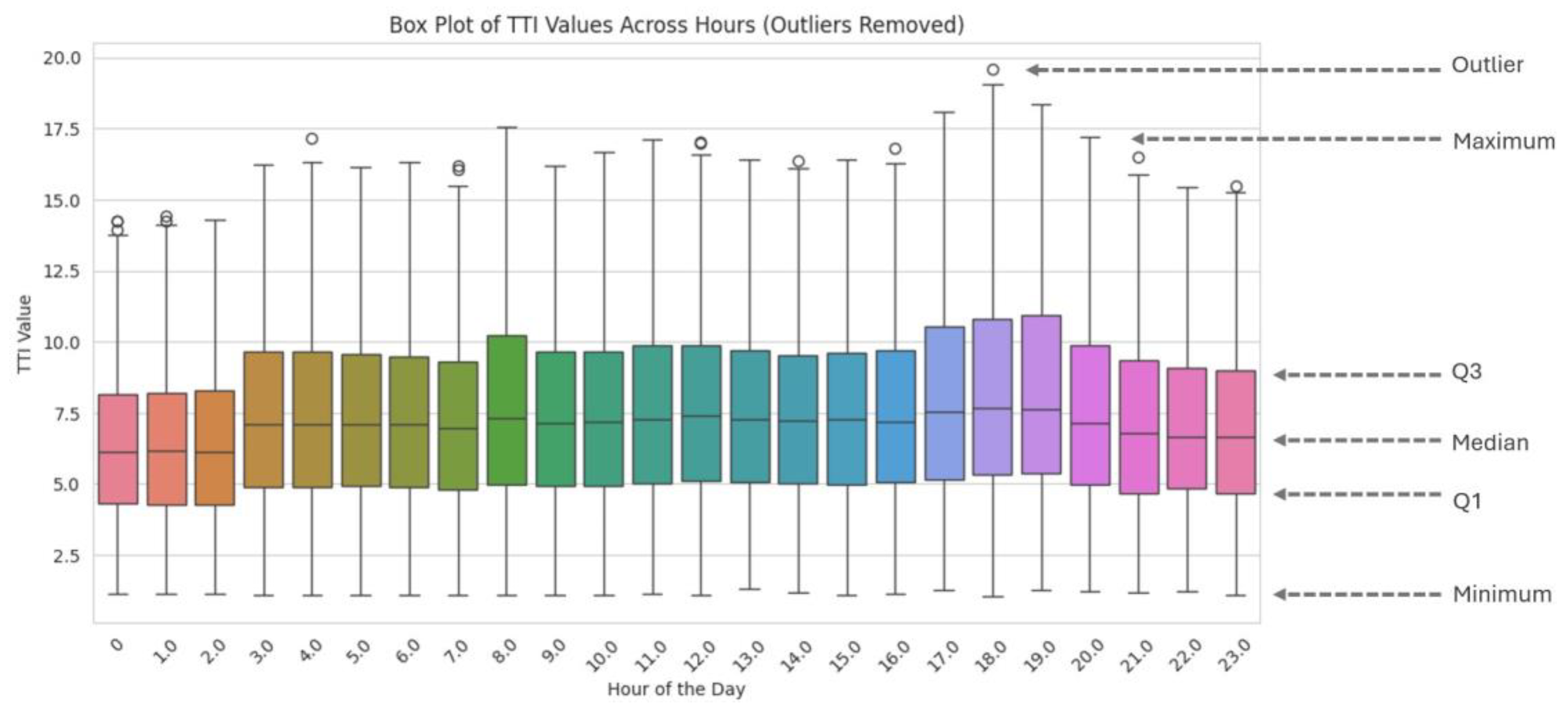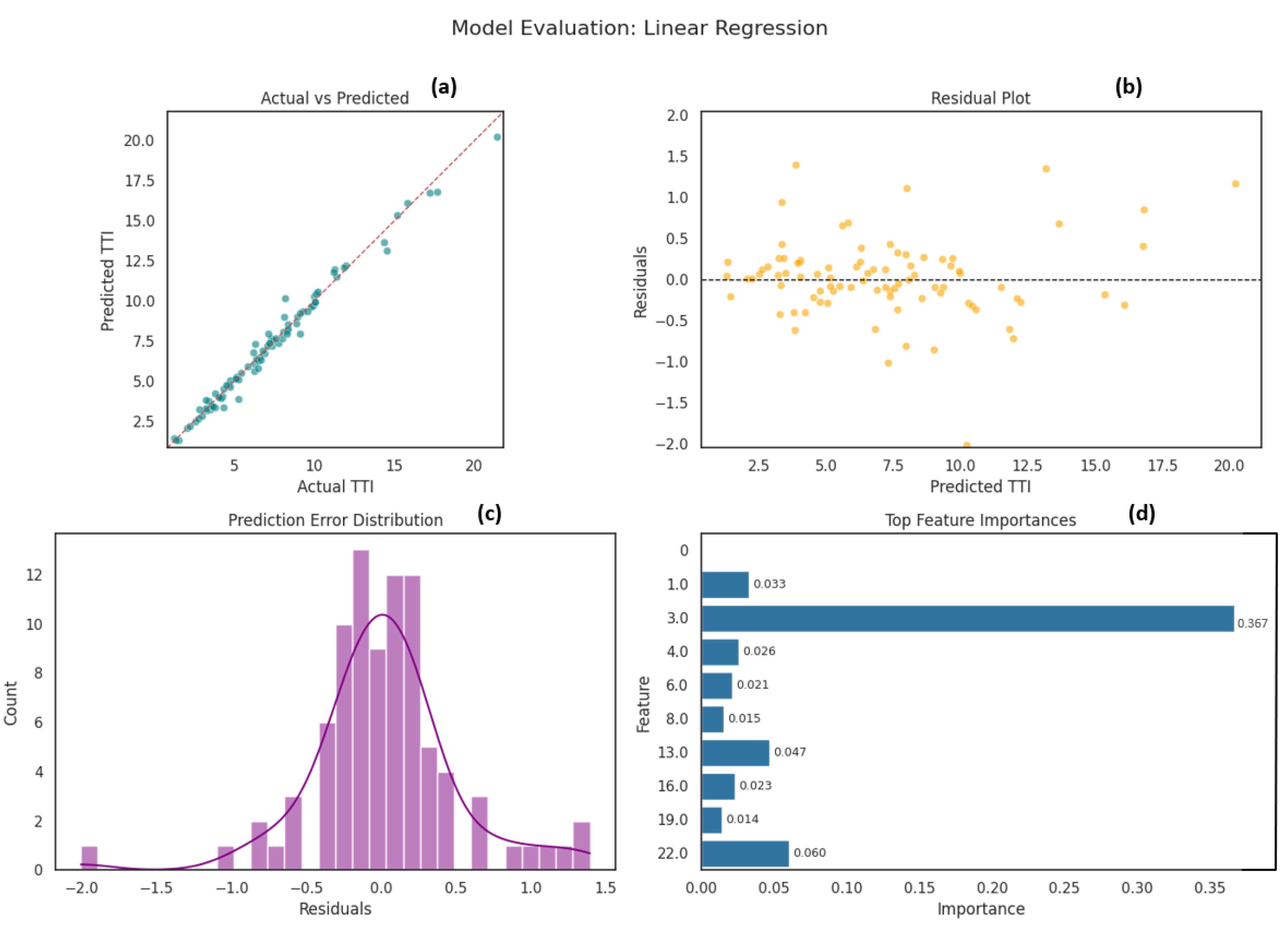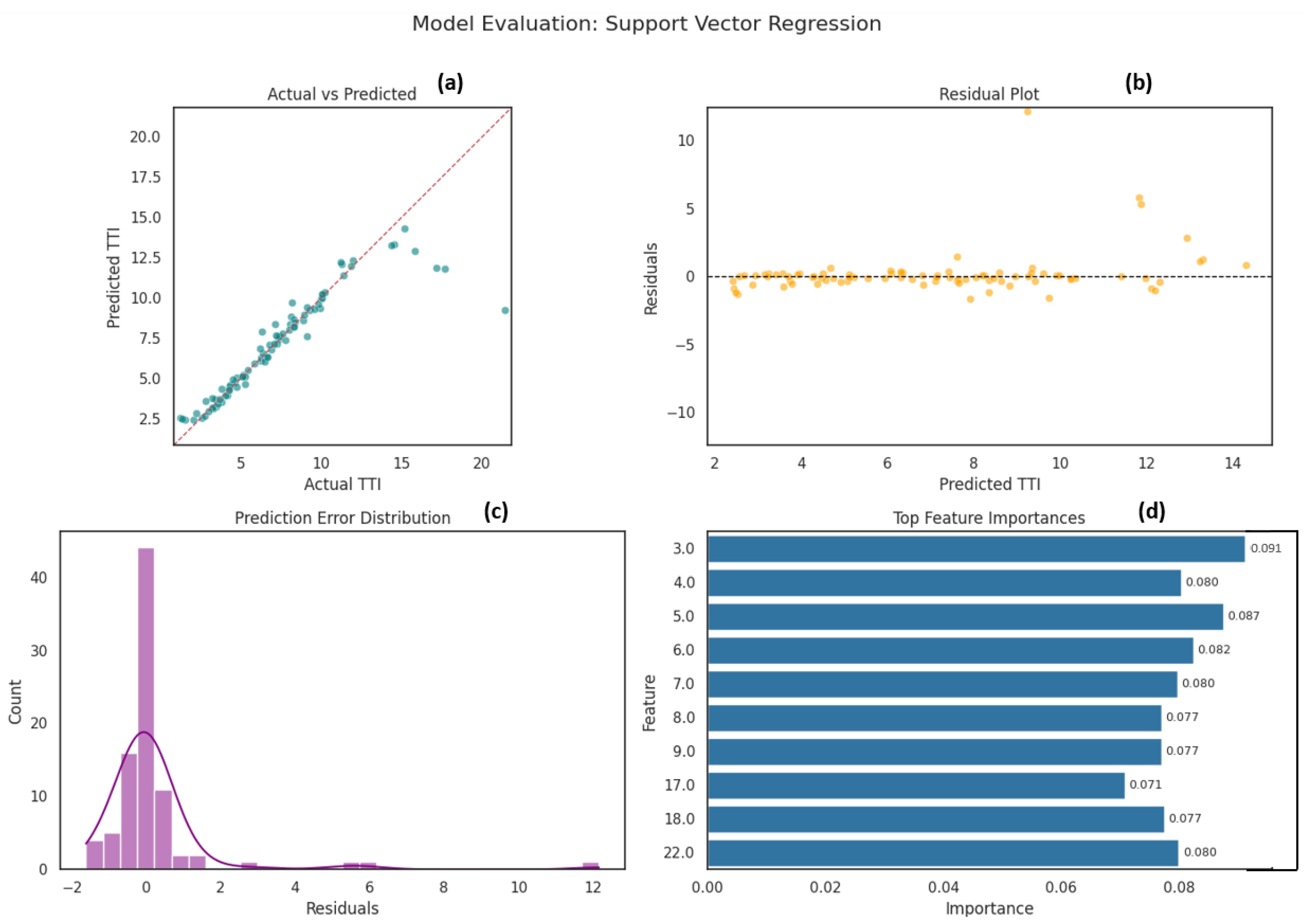AI for Motorized Travel Time Index Prediction: Enhancing Spatio-Temporal Urban Mobility Performance in Smart Cities
Abstract
1. Introduction
2. Study Area: Casablanca Smart City Context
3. Data, Materials, and Methodology
3.1. Data Sources, Collection, and Preprocessing
3.2. Research Methodology
3.3. Model Building
- is the average travel time during congested periods,
- is the travel time under ideal (uncongested) conditions.
- y is the target/dependent variable (TTI)
- is the intercept (bias term)
- are the slopes (weights)
- are the features (independent variables)
- the error
- Mean Absolute Error (MAE) measures the average magnitude of the errors between predicted values and actual observations, without considering their direction as defined in Equation (3) [62]. It provides an intuitive indication of how far predictions deviate from true values on average. Because it uses absolute values, MAE treats all errors equally and is less sensitive to outliers.
- n is the number of observations,
- is the observed (actual) value,
- is the predicted value.
- Mean Squared Error (MSE) calculates the average of the squared differences between predicted and actual values. By squaring the errors, it penalizes larger errors more heavily, making it sensitive to outliers. MSE is commonly used to assess overall model accuracy and is especially useful during model training. The mathematical expression is given below (Equation (4)):
- Root Mean Squared Error (RMSE) is the square root of the Mean Squared Error. It expresses the average magnitude of prediction errors in the original units of the target variable as defined in Equation (5). RMSE emphasizes larger errors due to the squaring step and is widely used to evaluate regression model performance [63,64].
- Coefficient of Determination (R2 Score) measures the proportion of variance in the observed data that is explained by the model [65] in Equation (6). It ranges from 0 to 1, where values closer to 1 indicate that the model explains most of the variability in the target variable, reflecting strong predictive power.
4. Results Analysis and Discussions
4.1. Statistical Analysis
4.2. Time Series Analysis
4.3. Geospatial Analysis
4.4. Predictive Model Performance Evaluation
Hyperparameter Tuning of the Random Forest Model
4.5. Practical Implications and Future Applications
- For non-motorized users (pedestrians and cyclists), the principal data sources are GPS-based crowd-sourced mobility apps that can generate travel-time indices. These datasets can be cleaned and aggregated to produce a Pedestrian TTI (TTIP)/Cyclist TTI (TTIC) analogous to the initial TTI. Pedestrian and cycling speeds are highly sensitive to environmental factors (weather conditions, steepness of a road, elevation, material and surface quality of the cycle paths, and sidewalk width). These additional covariates can be derived from sources like Digital Elevation Model (DEM) and OpenStreetMap (OSM) tags, which will help our high-performing predictive models (Random Forest and Gradient Boosting) retain strong predictive power if incorporated into the feature set.
- Rail, tram, and bus services generate structured timetabling information that can be accessed through the open data portals of the Moroccan National Railways Office (ONCF) and the tram/bus operators. By merging scheduled departure/arrival times with real-time vehicle location data, a Transit Travel Time Index (TTITr) can be calculated for each line segment, as with the road-based TTI. Since rail and bus networks are less dense than the road network, the model’s temporal granularity can be adjusted without loss of predictive accuracy. Moreover, passenger load information (available from ticket validation systems) can be introduced as an additional predictor to capture congestion-related delays.
- The adaptation involves data acquisition and preprocessing, feature engineering with mode-specific variables, retraining the model using the expanded dataset with additional covariates, and finally computing the same performance evaluation metrics (KPIs: MAE, MSE, RMSE, and R2). By following this method/workflow, our AI-driven framework can be generalized to cover the full modal split in the city of Casablanca.
5. Conclusions
Author Contributions
Funding
Data Availability Statement
Conflicts of Interest
Abbreviations
| AI | Artificial Intelligence |
| ITS | Intelligent Transportation Systems |
| TTI | Travel Time Index |
| MLR | Multivariate Linear Regression |
| RF | Random Forest |
| MLP | Multilayer Perceptron |
| SVR | Support Vector Regression |
| MAE | Mean Absolute Error |
| MSE | Mean Squared Error |
| RMSE | Root Mean Squared Error |
| R2 | R-squared |
| ARIMA | Auto-Regressive Integrated Moving Average |
| HA | Historical Averages |
| ML | Machine learning |
| DL | Deep Learning |
| LSTM | Long Short-Term Memory |
| CNN | Convolutional Neural Networks |
| RNNs | Recurrent Neural Networks |
| HCP | Higher Planning Commission |
| API | Application Programming Interface |
| GIS | Geographic Information System |
| IDW | Inverse Distance Weighted |
| ONCF | National Railways Office |
| OSM | OpenStreetMap |
| DEM | Digital Elevation Model |
| TTIP | Pedestrian TTI |
| TTIC | Cyclist TTI |
| TTITr | Transit Travel Time Index |
| SUMP | Sustainable Urban Mobility Plan |
| IQR | Interquartile Range Method |
References
- Population Reference Bureau. Urbanization Rate by Continent 2025. prb.org. Available online: https://www.statista.com/statistics/270860/urbanization-by-continent/ (accessed on 9 May 2025).
- United Nations, Department of Economic and Social Affairs, Population Division. Urban Population by Country (1950 and 2024 Comparison). Available online: https://worldostats.com/country-stats/urban-rural-population-by-country/ (accessed on 9 June 2025).
- Babaei, A.; Khedmati, M.; Jokar, M.R.A.; Tirkolaee, E.B. Sustainable transportation planning considering traffic congestion and uncertain conditions. Expert Syst. Appl. 2023, 227, 119792. [Google Scholar] [CrossRef]
- World Bank; United Nations Department of Economic and Social Affairs (UN DESA). Africa: Urbanization Rate by Country 2023. Available online: https://databank.worldbank.org (accessed on 9 June 2025).
- United Nations Population Division. World Urbanization Prospects: 2018 Revision. Available online: https://population.un.org/wup/assets/WUP2018-Report.pdf (accessed on 29 May 2025).
- Higher Planning Commission (HCP)-Morocco. Main Results of General Population and Housing Census. Rabat, Dec. 2024. Available online: https://www.hcp.ma/file/242665/ (accessed on 2 July 2025).
- Mitieka, D.; Luke, R.; Twinomurinzi, H.; Mageto, J. Smart Mobility in Urban Areas: A Bibliometric Review and Research Agenda. Sustainability 2023, 15, 6754. [Google Scholar] [CrossRef]
- Du, S.; Li, T.; Gong, X.; Horng, S.-J. A Hybrid Method for Traffic Flow Forecasting Using Multimodal Deep Learning. Int. J. Comput. Intell. Syst. 2020, 13, 85–97. [Google Scholar] [CrossRef]
- Wan, J.; Li, D.; Zou, C.; Zhou, K. M2M Communications for Smart City: An Event-Based Architecture. In Proceedings of the 2012 IEEE 12th International Conference on Computer and Information Technology (CIT), Chengdu, China, 27–29 October 2012; pp. 895–900. [Google Scholar] [CrossRef]
- Xu, H.; Berres, A.; Yoginath, S.B.; Sorensen, H.; Nugent, P.J.; Severino, J.; Tennille, S.A.; Moore, A.; Jones, W.; Sanyal, J. Smart Mobility in the Cloud: Enabling Real-Time Situational Awareness and Cyber-Physical Control Through a Digital Twin for Traffic. IEEE Trans. Intell. Transp. Syst. 2023, 24, 3145–3156. [Google Scholar] [CrossRef]
- Gohil, J.; Chauhan, Y.; Nimavat, D. Smart Traffic Management Using Transfer Learning Approach for Improve Urban Mobility. Int. J. Sci. Res. Comput. Sci. Eng. Inf. Technol. 2024, 10, 156–164. [Google Scholar] [CrossRef]
- Xu, Z.; Shahraki, A.S.; Rudolph, C. Blockchain-Based Malicious Behaviour Management Scheme for Smart Grids. Smart Cities 2023, 6, 3005–3031. [Google Scholar] [CrossRef]
- Sajadi, P.; Qorbani, M.; Moosavi, S.; Hassannayebi, E. Accident Impact Prediction Based on a Deep Convolutional and Recurrent Neural Network Model. Urban Sci. 2025, 9, 299. [Google Scholar] [CrossRef]
- Berres, A.; Moriano, P.; Xu, H.; Tennille, S.; Smith, L.; Storey, J.; Sanyal, J. A traffic accident dataset for Chattanooga, Tennessee. Data Brief. 2024, 55, 110675. [Google Scholar] [CrossRef]
- Alqhatani, M.; Setunge, S.; Mirodpour, S. Can a polycentric structure affect travel behaviour? A comparison of Melbourne, Australia and Riyadh, Saudi Arabia. J. Mod. Transp. 2014, 22, 156–166. [Google Scholar] [CrossRef]
- Bhaskara, J.A.; Nurmandi, A. Role of Artificial Intelligence in the Smart City: A Bibliometric Review. In Communications in Computer and Information Science; Springer Science and Business Media Deutschland GmbH: Berlin/Heidelberg, Germany, 2022; pp. 589–596. [Google Scholar] [CrossRef]
- Kirimtat, A.; Krejcar, O.; Kertesz, A.; Tasgetiren, M.F. Future Trends and Current State of Smart City Concepts: A Survey. IEEE Access 2020, 8, 86448–86467. [Google Scholar] [CrossRef]
- Prawiyogi, A.G.; Purnama, S.; Meria, L. Smart Cities Using Machine Learning and Intelligent Applications. Int. Trans. Artif. Intell. 2022, 1, 102–116. [Google Scholar] [CrossRef]
- Jiang, H.; Geertman, S.; Witte, P. The contextualization of smart city technologies: An international comparison. J. Urban Manag. 2022, 12, 33–43. [Google Scholar] [CrossRef]
- Lee, S.; Yang, J.; Cho, K.; Cho, D. The Influence of Transportation Accessibility on Traffic Volumes in South Korea: An Extreme Gradient Boosting Approach. Urban Sci. 2023, 7, 91. [Google Scholar] [CrossRef]
- Yusuf, O.; Rasheed, A.; Lindseth, F. Leveraging Big Data and AI for Sustainable Urban Mobility Solutions. Urban Sci. 2025, 9, 301. [Google Scholar] [CrossRef]
- Pali, P.; Verma, S.; Patel, A.; Pathak, V.; Soni, V. Intelligent Urban Transportation Systems (Iuts): A Survey of AI-Driven Innovations and Future Directions. Int. J. Innov. Res. Sci. Eng. Technol. 2023, 12, 8068–8073. [Google Scholar] [CrossRef]
- Ang, L.; Iwami, M.; Chen, Y.; Du, Z.; Liu, B.; Wang, F. A Systematic Review of Urban Design and Computer Modelling Methods to Support Smart City Development in a Post-COVID Era. Lect. Notes Civ. Eng. 2023, 211, 1234–1246. [Google Scholar] [CrossRef]
- Aljuaydi, F.; Wiwatanapataphee, B.; Wu, Y.H. Multivariate machine learning-based prediction models of freeway traffic flow under non-recurrent events. Alex. Eng. J. 2022, 65, 151–162. [Google Scholar] [CrossRef]
- Liyanage, S.; Abduljabbar, R.; Dia, H.; Tsai, P.-W. AI-based neural network models for bus passenger demand forecasting using smart card data. J. Urban Manag. 2022, 11, 365–380. [Google Scholar] [CrossRef]
- Li, Y.; Zhao, W.; Fan, H. A Spatio-Temporal Graph Neural Network Approach for Traffic Flow Prediction. Mathematics 2022, 10, 1754. [Google Scholar] [CrossRef]
- Jilani, U.; Asif, M.; Zia, M.Y.I.; Rashid, M.; Shams, S.; Otero, P. A Systematic Review on Urban Road Traffic Congestion. Wirel. Pers. Commun. 2023, 140, 81–109. [Google Scholar] [CrossRef]
- Pramanik, A.; Rahman, M.; Anam, A.S.M.I.; Ali, A.A.; Amin, M.A.; Rahman, A.K.M.M. Modeling Traffic Congestion in Developing Countries using Google Maps Data. arXiv 2020, arXiv:2011.02359. [Google Scholar]
- Kashyap, A.A.; Raviraj, S.; Devarakonda, A.; K, S.R.N.; V, S.K.; Bhat, S.J. Traffic flow prediction models—A review of deep learning techniques. Cogent Eng. 2021, 9, 1–24. [Google Scholar] [CrossRef]
- Moriano, P.; Berres, A.; Xu, H.; Sanyal, J. Spatiotemporal features of traffic help reduce automatic accident detection time. Expert Syst. Appl. 2023, 244, 122813. [Google Scholar] [CrossRef]
- Liu, T.; Meidani, H. Graph neural networks for travel distance estimation and route recommendation under probabilistic hazards. Int. J. Transp. Sci. Technol. 2025. [Google Scholar] [CrossRef]
- Khalifa, A.; Idsouguou, Y.; Benabbou, L.; Zirari, M. Machine Learning Approaches for Traffic Volume Forecasting: A Case Study of the Moroccan Highway Network. arXiv 2017, arXiv:1711.06779. [Google Scholar] [CrossRef]
- Bibri, S.E.; Allam, Z. The Metaverse as a virtual form of data-driven smart cities: The ethics of the hyper-connectivity, datafication, algorithmization, and platformization of urban society. Comput. Urban Sci. 2022, 2, 1–22. [Google Scholar] [CrossRef]
- Lukic Vujadinovic, V.; Damnjanovic, A.; Cakic, A.; Petkovic, D.R.; Prelevic, M.; Pantovic, V.; Stojanovic, M.; Vidojevic, D.; Vranjes, D.; Bodolo, I. AI-Driven Approach for Enhancing Sustainability in Urban Public Transportation. Sustainability 2024, 16, 7763. [Google Scholar] [CrossRef]
- Zhang, T.; Xu, J.; Cong, S.; Qu, C.; Zhao, W. A Hybrid Method of Traffic Congestion Prediction and Control. IEEE Access 2023, 11, 36471–36491. [Google Scholar] [CrossRef]
- Bibri, S.E.; Krogstie, J. The emerging data–driven Smart City and its innovative applied solutions for sustainability: The cases of London and Barcelona. Energy Inform. 2020, 3, 5. [Google Scholar] [CrossRef]
- Makhoul, N. Review of data quality indicators and metrics, and suggestions for indicators and metrics for structural health monitoring. Adv. Bridg. Eng. 2022, 3, 1–32. [Google Scholar] [CrossRef]
- Makhoul, N. Bayesian Decision-Making Process Including Structural Health Monitoring Data Quality for Bridge Management. KSCE J. Civ. Eng. 2024, 28, 2818–2835. [Google Scholar] [CrossRef]
- Yang, L.; Shami, A. On hyperparameter optimization of machine learning algorithms: Theory and practice. Neurocomputing 2020, 415, 295–316. [Google Scholar] [CrossRef]
- Vemuri, S.; François-Jacobs, É.; Ambrosino, G.; González, N.C.; Gómez, M.; Bochinska, Z.; Baffi, S.; Boudet, L.; Heitplatz, A.; Almendros Salerno, A. MobiliseYourCity Global Monitor 2025—Factsheet: Casablanca, Morocco. Available online: www.mobiliseyourcity.net (accessed on 17 July 2025).
- Waze Data API. Waze for Cities: Your Partner for Mobility. Available online: https://www.waze.com/fr/wazeforcities (accessed on 8 November 2024).
- Kendall, K.M.; Stuart, A. The Advanced Theory of Statistics. Vol.3: Design and Analysis, and Time-Series. Griffin. (A Classic Text Covering Foundational Statistical Methods). ats. 1976, Volume 3. Available online: https://ui.adsabs.harvard.edu/abs/1976ats..book.....K/abstract (accessed on 19 July 2025).
- James, G.; Witten, D.; Hastie, T.; Tibshirani, R. An Introduction to Statistical Learning, 2nd ed.; Springer: New York, NY, USA, 2021; ISBN 9781071614174. [Google Scholar]
- Breiman, L. Random forests. Mach. Learn. 2001, 45, 5–32. [Google Scholar] [CrossRef]
- Sideris, N.; Bardis, G.; Voulodimos, A.; Miaoulis, G.; Ghazanfarpour, D. Using Random Forests on Real-World City Data for Urban Planning in a Visual Semantic Decision Support System. Sensors 2019, 19, 2266. [Google Scholar] [CrossRef]
- Rodriguez-Galiano, V.F.; Ghimire, B.; Rogan, J.; Chica-Olmo, M.; Rigol-Sanchez, J.P. An assessment of the effectiveness of a random forest classifier for land-cover classification. ISPRS J. Photogramm. Remote Sens. 2012, 67, 93–104. [Google Scholar] [CrossRef]
- Mutale, B.; Withanage, N.C.; Mishra, P.K.; Shen, J.; Abdelrahman, K.; Fnais, M.S. A Performance Evaluation of Random Forest, Artificial Neural Network, and Support Vector Machine Learning Algorithms to Predict Spatio-Temporal Land Use-Land Cover Dynamics: A Case from Lusaka and Colombo. Front. Environ. Sci. 2024, 12, 1431645. [Google Scholar] [CrossRef]
- Louppe, G.; Wehenkel, L.; Sutera, A.; Geurts, P. Understanding variable importances in forests of randomized trees. In Advances in Neural Information Processing Systems; Burges, C.J., Bottou, L., Welling, M., Ghahramani, Z., Weinberger, K.Q., Eds.; Curran Associates, Inc.: Red Hook, NY, USA, 2013; Available online: https://proceedings.neurips.cc/paper_files/paper/2013/file/e3796ae838835da0b6f6ea37bcf8bcb7-Paper.pdf (accessed on 20 July 2025).
- Chen, T.; Guestrin, C. XGBoost: A Scalable Tree Boosting System. In Proceedings of the 22nd ACM SIGKDD International Conference on Knowledge Discovery and Data Mining (KDD ‘16), San Francisco, CA, USA, 13–17 August 2016; pp. 785–794. [Google Scholar] [CrossRef]
- Natekin, A.; Knoll, A. Gradient boosting machines, a tutorial. Front. Neurorobotics. 2013, 7, 21. [Google Scholar] [CrossRef]
- Rumelhart, D.E.; Hinton, G.E.; Williams, R.J. Learning representations by back-propagating errors. Nature 1986, 323, 533–536. [Google Scholar] [CrossRef]
- LeCun, Y.; Bengio, Y.; Hinton, G. Deep learning. Nature 2015, 521, 436–444. [Google Scholar] [CrossRef] [PubMed]
- Heaton, J. Ian Goodfellow, Yoshua Bengio, and Aaron Courville: Deep learning. Genet. Program. Evolvable Mach. 2017, 19, 305–307. [Google Scholar] [CrossRef]
- Vapnik, V.N. (Ed.) Introduction: Four Periods in the Research of the Learning Problem. In The Nature of Statistical Learning Theory; Springer: New York, NY, USA, 2000; pp. 1–15. [Google Scholar] [CrossRef]
- Drucker, H.; Burges, C.J.C.; Kaufman, L.; Smola, A.; Vapnik, V.N. Support Vector Regression Machines. In Proceedings of the Advances in Neural Information Processing Systems (NIPS), Denver, CO, USA, 2–5 December 1996; Mozer, M.C., Jordan, M., Petsche, T., Eds.; Morgan Kaufmann: San Mateo, CA, USA; MIT Press: Cambridge, MA, USA, 1997; Volume 9, pp. 155–161. Available online: https://proceedings.neurips.cc/paper_files/paper/1996/file/d38901788c533e8286cb6400b40b386d-Paper.pdf (accessed on 12 February 2025).
- Smola, A.J.; Schölkopf, B. A tutorial on support vector regression. Stat. Comput. 2004, 14, 199–222. [Google Scholar] [CrossRef]
- Bishop, C.M. Pattern Recognition and Machine Learning; Springer: Singapore, 2006. [Google Scholar]
- Rouky, N.; Bousouf, A. Dataset for Traffic Analysis in Casablanca, Morocco. Mendeley Data 2023, 1. [Google Scholar] [CrossRef]
- Rouky, N.; Bousouf, A.; Benmoussa, O.; Fri, M. A spatiotemporal analysis of traffic congestion patterns using clustering algorithms: A case study of Casablanca. Decis. Anal. J. 2024, 10, 100404. [Google Scholar] [CrossRef]
- Texas A&M Transportation Institute. 2023 Urban Mobility Report; Texas A&M Transportation Institute: Austin, TX, USA, 2024; Available online: https://static.tti.tamu.edu/tti.tamu.edu/documents/umr/archive/mobility-report-2023.pdf (accessed on 6 May 2025).
- Schrank, D.L.; Lomax, T.; Texas A&M Transportation Institute. The 2005 Urban Mobility Report; Texas A&M Transportation Institute: Austin, TX, USA, 2005. Available online: https://rosap.ntl.bts.gov/view/dot/61838 (accessed on 6 May 2025).
- Dorosan, M.; Dailisan, D.; Valenzuela, J.F.; Monterola, C. Use of machine learning in understanding transport dynamics of land use and public transportation in a developing city. Cities 2023, 144, 104587. [Google Scholar] [CrossRef]
- Makhoul, N.; Derras, B. Machine Learning Improving Seismic Infrastructure Recovery Time Estimation. In Bridge Maintenance, Safety, Management, Digitalization and Sustainability; Casas, J.R., Frangopol, D.M., Turmo, J., Eds.; CRC Press: London, UK, 2024; pp. 3276–3285. [Google Scholar] [CrossRef]
- Bajaj, M.R.; Kumar, N.-R. A Research Paper on AI for Traffic Management. Available online: https://doi.org/10.13140/RG.2.2.21119.69287 (accessed on 9 April 2025).
- Ma, C. Smart city and cyber-security; technologies used, leading challenges and future recommendations. Energy Rep. 2021, 7, 7999–8012. [Google Scholar] [CrossRef]
- Moumen, N.; Radoine, H.; Nahiduzzaman, K.M.; Oulidi, H.J. Smartainity: A Comprehensive Framework for Urban Performance Assessment in African Smart Cities with Key Performance Indicators. In Lecture Notes in Networks and Systems; Springer: Cham, Switzerland, 2024; Volume 931, pp. 126–138. [Google Scholar] [CrossRef]
- Moumen, N.; Radoine, H.; Nahiduzzaman, K.M.; Oulidi, H.J. Contextualizing the Smart City in Africa: Balancing Human-Centered and Techno-Centric Perspectives for Smart Urban Performance. Smart Cities 2024, 7, 712–734. [Google Scholar] [CrossRef]
- Rodrigues, F. On the Importance of Stationarity, Strong Baselines and Benchmarks in Transport Prediction Problems. In Proceedings of the 2023 IEEE 26th International Conference on Intelligent Transportation Systems (ITSC), Bilbao, Spain, 24–28 September 2023; pp. 4927–4932. [Google Scholar]
- Alomari, A.H.; Khedaywi, T.S.; Marian, A.R.O.; Jadah, A.A. Traffic speed prediction techniques in urban environments. Heliyon 2022, 8, e11847. [Google Scholar] [CrossRef] [PubMed]
- Feng, X.; Ahvar, E.; Lee, G.M. Evaluation of Machine Leaning Algorithms for Streets Traffic Prediction: A Smart Home Use Case. Sensors 2023, 23, 2174. [Google Scholar] [CrossRef] [PubMed]
- Razali, N.A.M.; Shamsaimon, N.; Ishak, K.K.; Ramli, S.; Amran, M.F.M.; Sukardi, S. Gap, techniques and evaluation: Traffic flow prediction using machine learning and deep learning. J. Big Data 2021, 8, 1–25. [Google Scholar] [CrossRef]
- Ashwini, B.P.; Sumathi, R.; Sudhira, H.S. Bus Travel Time Prediction: A Comparative Study of Linear and Non-Linear Machine Learning Models. J. Phys. Conf. Ser. 2022, 2161, 012053. [Google Scholar] [CrossRef]
- Sun, P.; Boukerche, A.; Tao, Y. SSGRU: A novel hybrid stacked GRU-based traffic volume prediction approach in a road network. Comput. Commun. 2020, 160, 502–511. [Google Scholar] [CrossRef]
- Bratsas, C.; Koupidis, K.; Salanova, J.-M.; Giannakopoulos, K.; Kaloudis, A.; Aifadopoulou, G. A Comparison of Machine Learning Methods for the Prediction of Traffic Speed in Urban Places. Sustainability 2019, 12, 142. [Google Scholar] [CrossRef]
- Zhao, Y.; Zhang, W.; Liu, X. Grid search with a weighted error function: Hyper-parameter optimization for financial time series forecasting. Appl. Soft Comput. 2024, 154, 111362. [Google Scholar] [CrossRef]
- Pedregosa, F.; Varoquaux, G.; Gramfort, A.; Michel, V.; Thirion, B.; Grisel, O.; Blondel, M.; Prettenhofer, P.; Weiss, R.; Dubourg, V.; et al. Scikit-learn: Machine Learning in Python. J. Mach. Learn. Res. 2011, 12, 2825–2830. Available online: http://scikit-learn.sourceforge.net (accessed on 27 July 2025).
- Li, X.; Wang, H.; Sun, P.; Zu, H. Spatiotemporal Features—Extracted Travel Time Prediction Leveraging Deep-Learning-Enabled Graph Convolutional Neural Network Model. Sustainability 2021, 13, 1253. [Google Scholar] [CrossRef]













| Attributes Abbreviation | Description |
|---|---|
| Cne_Name | Commune Name |
| P_Code | Postal/Zip Code |
| O_Id | Origin Index |
| O_Coords | Origin Coordinates |
| O_Lat | Latitude of the Origin |
| O_Long | Longitude of the Origin |
| D_Id | Destination Index |
| D_Coords | Destination Coordinates |
| D_Lat | Latitude of the Destination |
| D_Long | Longitude of the Destination |
| Dist | Distance of the segment road (km) |
| TRT | Travel Real Time (min) at each hour |
| TTI | Travel Time Index (TTI) |
| Model | Actual vs. Predicted Fit | Residual Analysis | Error Distribution | Feature Importance | Overall Performance Metrics |
|---|---|---|---|---|---|
| Multivariate Linear Regression (MLR) | Wide scatter; underfits nonlinear patterns | Patterned residuals; Biased | Broad and symmetrical; potential Bi-directional errors | Not scale-consistent | Simple baseline. limited accuracy |
| Random Forest (RF) | Tight clustering; strong fit | Random residuals; low bias | Narrow, centered | Clear, interpretable hierarchy | Robust; handles nonlinearity well |
| Gradient Boosting (XGBoost) | Slightly tighter than RF; nuanced fit | Small residual spread; slight variation at high values | Centered, minor asymmetry | Focused on a few dominant features | Highly accurate; prone to overfit if untuned |
| Neural Network (MLP) | Decent fit: more scatter than RF/GB | Higher variance; less generalization | Wider error spread: more noise | Not interpretable | Potentially good with tuning; less stable |
| Support Vector Regressor (SVR) | Fair alignment; sparser clustering; struggles at extremes | Erratic residuals, especially at high predictions | Wider, slightly skewed errors | Not available | Slower, less scalable; lower accuracy; less interpretable |
| Parameter | Description | Example Values |
|---|---|---|
| n_estimators | Number of trees in the forest | 100 |
| max_depth | Maximum depth of each tree | 10 |
| min_samples_split | Minimum samples needed to split a node | 2 |
| Metric | Initial Value | Tuned Value |
|---|---|---|
| MAE | 0.315 | 0.220 |
| MSE | 0.214 | 0.123 |
| RMSE | 0.463 | 0.351 |
| R2 | 0.985 | 0.988 |
Disclaimer/Publisher’s Note: The statements, opinions and data contained in all publications are solely those of the individual author(s) and contributor(s) and not of MDPI and/or the editor(s). MDPI and/or the editor(s) disclaim responsibility for any injury to people or property resulting from any ideas, methods, instructions or products referred to in the content. |
© 2025 by the authors. Licensee MDPI, Basel, Switzerland. This article is an open access article distributed under the terms and conditions of the Creative Commons Attribution (CC BY) license (https://creativecommons.org/licenses/by/4.0/).
Share and Cite
Moumen, N.; Bahi, H.; Makhoul, N.; Chenal, J. AI for Motorized Travel Time Index Prediction: Enhancing Spatio-Temporal Urban Mobility Performance in Smart Cities. Urban Sci. 2025, 9, 499. https://doi.org/10.3390/urbansci9120499
Moumen N, Bahi H, Makhoul N, Chenal J. AI for Motorized Travel Time Index Prediction: Enhancing Spatio-Temporal Urban Mobility Performance in Smart Cities. Urban Science. 2025; 9(12):499. https://doi.org/10.3390/urbansci9120499
Chicago/Turabian StyleMoumen, Nessrine, Hicham Bahi, Nisrine Makhoul, and Jérôme Chenal. 2025. "AI for Motorized Travel Time Index Prediction: Enhancing Spatio-Temporal Urban Mobility Performance in Smart Cities" Urban Science 9, no. 12: 499. https://doi.org/10.3390/urbansci9120499
APA StyleMoumen, N., Bahi, H., Makhoul, N., & Chenal, J. (2025). AI for Motorized Travel Time Index Prediction: Enhancing Spatio-Temporal Urban Mobility Performance in Smart Cities. Urban Science, 9(12), 499. https://doi.org/10.3390/urbansci9120499








